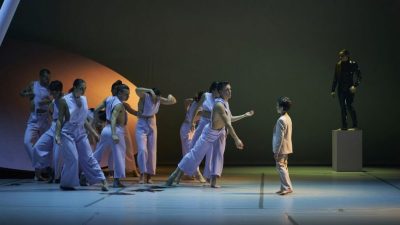One of the most enigmatic and celebrated works in the history of music will be performed at the Bartók Spring Festival in April by legendary Dutch conductor Ton Koopman and the Amsterdam Baroque Orchestra and Choir, founded by him. Why did the Lutheran composer and choirmaster of St Thomas’s Church in Leipzig write a monumental Catholic Mass in Latin? Why did he go back to works composed decades earlier to reinterpret them before his death? And could Bach ever have heard this masterpiece, which lasts more than two hours?
The genesis of the Mass in B minor is one of the great mysteries of music history. Bach completed it in 1749, the year before his death, and in composing it he used and reworked many of his earlier works. By this time, the Sanctus, Kyrie and Gloria had been in existence for many years. The Sanctus, composed in 1724, was performed as part of a Christmas service in Leipzig. Bach wrote the Missas, consisting of the Kyrie and Gloria, in 1733 for the Elector of Saxony, Frederick Augustus, who was inaugurated that year, and from whom he hoped to – and later received – the title of court composer. It is conceivable that the sad, plaintive Kyrie mourns the death of the previous Elector, Augustus II, while the triumphant Gloria celebrates the new monarch.
There would be nothing strange about the origin of these works, since the Kyrie and Gloria are part of the Lutheran liturgy. However, it is still not entirely clear why, in the late 1740s, the composer, who was by then elderly and in declining health, decided to revisit these works and expand them into a two-hour-plus Mass in the Catholic liturgy.
Perhaps he had composed it for a Catholic church. Unlikely, because Catholics in Saxony did not like long masses; unlike the several-hour services of the Evangelicals, Catholic churches usually had services lasting an hour or less. Or perhaps he was preparing for a coronation? At the time, however, coronations were not expected in the area. In an interview before a concert in Berlin, Ton Koopman explained what he considered to be the most likely explanation. In 1749, a Bohemian count named von Sporck wrote a letter to Bach. A note has survived which says that this letter was delivered, but nothing is known about what it might have contained. A music historian, Michael Maul, speculates that the Count may have commissioned music from Bach for a series of charity concerts in Vienna on St Cecilia’s Day, which were particularly popular for monumental works that attracted large audiences. Perhaps that is why the Mass in B minor was composed.

So Bach brought out the Sanctus, Kyrie and Gloria, but also went back to his own earlier works when composing the rest of the Mass, rewriting and updating them. The Crucifixus, for example, comes from the early Weimar Cantata BWV 12, composed in 1714, but the composer added a few bars to the end. According to Koopman, this is
“the most modern music Bach ever wrote, and these moments are simply indescribably wonderful”.
Bach’s entire oeuvre is encapsulated in this work, which is extremely varied and diverse, yet harmonious as a whole. Large-scale choral movements, passages reminiscent of Renaissance music and Gregorian chant, intimate, soaring arias, fugues and dances make up the symmetrical structure, with the Credo, the revelation of faith, at its centre and the Crucifixus passacaglia, the oldest part of the Mass in B minor, originally from 1714, at its centre.
When Bach composed the Mass in B minor, he was already very ill, as his handwriting clearly shows: he formed the letters like a child barely learning to write, and soon afterwards he lost his sight. The Mass in B minor was his last major work. It was not performed during his lifetime and was not heard for over a hundred years after his death. Although parts of it were performed here and there over the decades, it was not performed in its entirety until 1859.
The Mass in B minor is monumental not only in its duration but also in the apparatus it features: two choirs and countless wind players appear alongside orchestra and vocal soloists.
“The most colourful work one can imagine”
– said Ton Koopman, who after many decades has not lost his almost childlike enthusiasm for Bach’s art. The conductor, who has won numerous awards, has a palpable respect for Bach’s music in his performances. The intellectual joy of this music is evident in his every move: he conducts with a broad smile, his eyes bright, and a happy awe that captivates the listener.
One of the greatest Bach experts of our time, harpsichordist, organist, musicologist and conductor Ton Koopman was only 25 when he founded the Amsterdam Baroque Orchestra in 1979. A frequent organist and harpsichordist, Koopman also gives recitals – for example, in Budapest in 2016 he played works by Bach and Buxtehude on the huge organ of the Müpa Budapest – and in 1992 he founded the Amsterdam Baroque Choir. At the lead of the two ensembles, he has been serving Bach’s music unstoppably ever since. Together they have recorded all of the composer’s surviving cantatas and have toured tirelessly to every corner of the world, taking his sacred and secular cantatas and passions to every corner of the world. Alongside these works, the monumental, indecipherable Mass in B minor is a frequent feature of their repertoire: on 16 April 2022, audiences in Budapest will be able to witness this unique and highly influential masterpiece with Elisabeth Breuer, Maarten Engeltjes, Tilman Lichdi and Klaus Mertens at Müpa Budapest.
You can get your tickets here.
Article: Zsuzsanna Deák
Translation: Nóra Fehér



























Comments